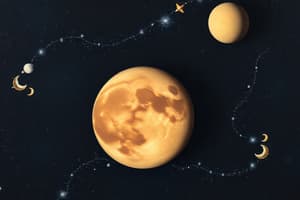Podcast
Questions and Answers
What distinguishes a dwarf planet like Ceres or Pluto from a full planet?
What distinguishes a dwarf planet like Ceres or Pluto from a full planet?
- Dwarf planets are significantly larger than full planets.
- Dwarf planets do not have sufficient mass for a nearly round shape. (correct)
- Dwarf planets do not orbit a star.
- Dwarf planets lack moons.
Which of the following correctly describes the organization of star systems?
Which of the following correctly describes the organization of star systems?
- Star systems are exclusively composed of single stars.
- Star systems contain only stars that are the same age.
- Star systems are always part of larger clusters.
- Star systems can include multiple stars and are often pairs known as binary stars. (correct)
What is a defining characteristic of open star clusters compared to globular clusters?
What is a defining characteristic of open star clusters compared to globular clusters?
- Open clusters are usually composed of stars of similar colors.
- Open clusters typically contain older stars.
- Globular clusters have a higher number of stars. (correct)
- Globular clusters are generally found near the periphery of galaxies.
What primary feature of the Milky Way galaxy is recognized today?
What primary feature of the Milky Way galaxy is recognized today?
What is the definition of a light year in astronomy?
What is the definition of a light year in astronomy?
Flashcards
What is the formal definition of a planet?
What is the formal definition of a planet?
A celestial body that orbits a star, is massive enough for its own gravity to overcome rigid body forces so that it assumes a nearly round shape, and has cleared the neighborhood around its orbit.
Why do dwarf planets like Ceres or Pluto fail to meet the definition of a planet?
Why do dwarf planets like Ceres or Pluto fail to meet the definition of a planet?
Dwarf planets have not cleared the neighborhood around their orbits, meaning they share their orbital space with other objects of comparable size. They exhibit a nearly round shape but lack dominance over their orbital region.
What is the difference between open and globular star clusters?
What is the difference between open and globular star clusters?
Open clusters are loosely bound groups of young, hot, and blue stars, while globular clusters are tightly bound groups of older, cooler, and redder stars.
What is an astronomical unit (AU)?
What is an astronomical unit (AU)?
Signup and view all the flashcards
What is 'look-back time' in astronomy?
What is 'look-back time' in astronomy?
Signup and view all the flashcards
Study Notes
Our Place in the Universe: Hierarchy of Structure
- Planet Definition: A formal definition of a planet exists, differentiating it from dwarf planets like Ceres or Pluto.
- Dwarf Planet Discrepancy: Dwarf planets fail to meet the necessary criteria to be considered a planet.
- Solar System: A solar system can involve more than one star, often forming binary star systems. The planets are significantly smaller than the solar system itself.
- Star Clusters: Two types of star clusters exist:
- Open Star Clusters: Contain a smaller number of younger stars that are typically bluer.
- Globular Star Clusters: Contain a larger number of older stars that are typically redder.
- Milky Way Galaxy: A galaxy includes star clusters and individual stars revolving around a central point, a supermassive black hole. The galaxy's center lies within the Sagittarius constellation.
- Local Group: The Local Group is a galaxy cluster comprising major galaxies like Andromeda, Milky Way, and Triangulum, alongside smaller ones.
- Laniakea Supercluster: The Laniakea Supercluster is a part of the larger universe.
- The Universe: The entire universe includes all existing energy and matter.
Units in Astronomy
- Astronomical Unit (AU): A unit of measurement used in astronomy.
- Light Year (ly): A unit of measurement based on the distance light travels in a year, commonly used in space.
Look-back Time
- Distance and Time Relation: The further astronomers observe in space, the further back in time they see due to the time taken for light to travel.
Studying That Suits You
Use AI to generate personalized quizzes and flashcards to suit your learning preferences.




